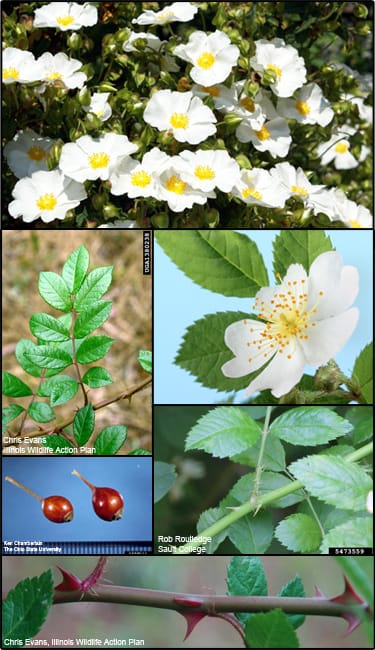|
Multiflora rose (Rosa multiflora)
Introduced to North America from Japan in the 1860s as rootstock for ornamental roses.
What problems does multiflora rose cause? Like most invasive plants, multiflora rose forms monocultures that replace native plants in high quality natural areas, which in turn reduces critical food resources for birds, butterflies, and other wild creatures. Multiflora rose was used as a “living fence” and can quickly become an inpenetrable thicket once it takes hold in an area. The stems can act like a vine around a tree. Any stems touching the ground can take root and grow into a new plant (called layering). Multiflora rose can also be spread by birds digesting the seed. A combination of these methods of reproduction can allow populations of multiflora rose get quickly out of control. What does multiflora rose look like? Multiflora rose is a shrub with arching stems that can be 3-10 feet in height. The green stems almost always have red prickles that can be easily pulled from the stem and the leaves are small, toothed, and elliptical shaped, arranged in leaflets of 7-10 along the stem. Multiflora rose can be distinguished from other rose species by its fringed stipules—small leaflet-like structures at the base of the leaf. It has small white flowers with 5 petals, about an inch in diameter, which bloom in June . How do I manage multiflora rose? If detected early, small patches of multiflora rose can be eradicated with repeated cuttings and close monitoring. The best way to keep multiflora rose out is to closely monitor natural areas for signs of multiflora rose, and act quickly if found. Treatment options vary depending on many factors such as density and the environment that the plant is in. You can find very thorough treatment instructions using the Midwest Invasive Plant Network (MIPN) control database (http://mipncontroldatabase.wisc.edu/). |
|
| habitatmatters.org |
Contact US231-252-4148
3334 Veterans Drive Unit A Traverse City, Michigan 49685 |
Pleasant Peninsula Design, Habitat Matters 2017



